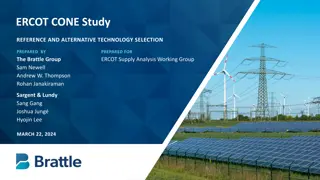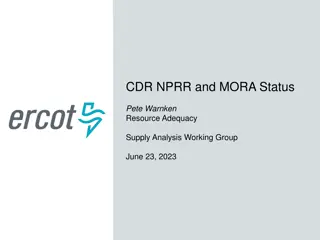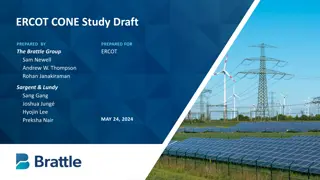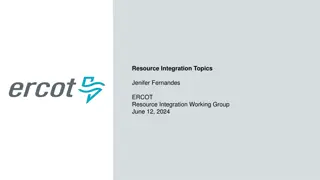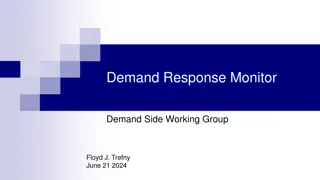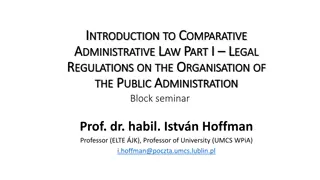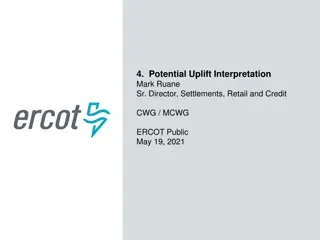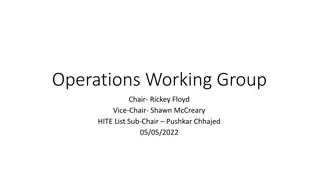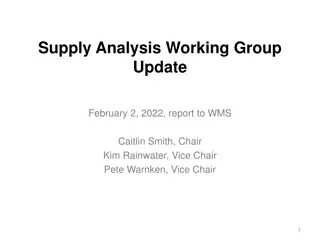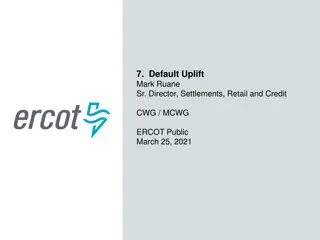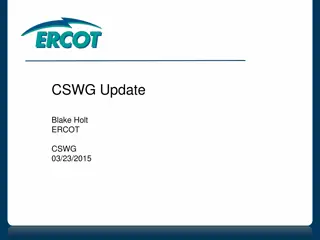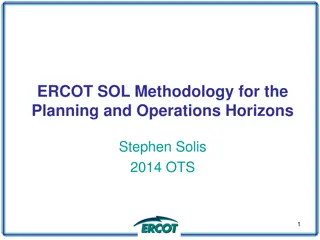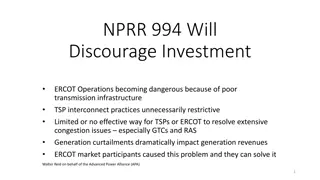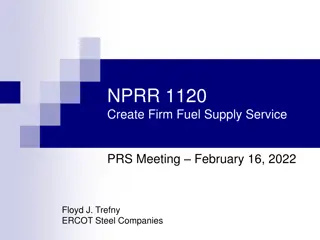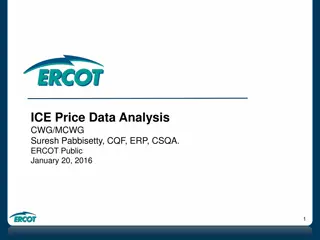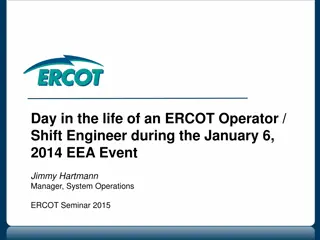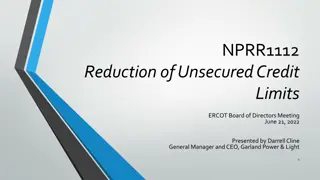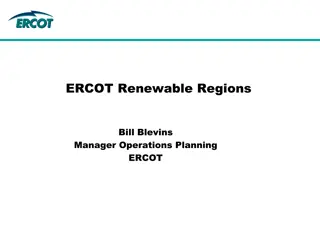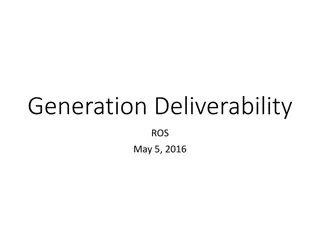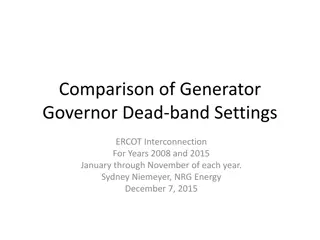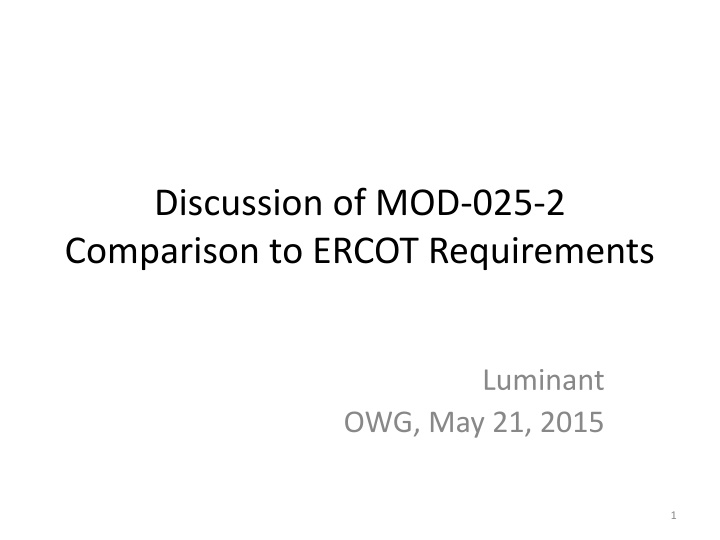
Comparison of ERCOT Requirements with MOD-025-2 and Proposed Revisions
Explore the differences between ERCOT requirements and MOD-025-2 NERC standard, proposing revisions for harmonization. Topics include facility criteria, testing periodicity, real power verification, and reactive testing. Considerations for ERCOT Operations during peak load periods are also discussed.
Download Presentation

Please find below an Image/Link to download the presentation.
The content on the website is provided AS IS for your information and personal use only. It may not be sold, licensed, or shared on other websites without obtaining consent from the author. If you encounter any issues during the download, it is possible that the publisher has removed the file from their server.
You are allowed to download the files provided on this website for personal or commercial use, subject to the condition that they are used lawfully. All files are the property of their respective owners.
The content on the website is provided AS IS for your information and personal use only. It may not be sold, licensed, or shared on other websites without obtaining consent from the author.
E N D
Presentation Transcript
Discussion of MOD-025-2 Comparison to ERCOT Requirements Luminant OWG, May 21, 2015 1
Introduction Identify requirements of the ERCOT Protocols and Operating Guides which are not harmonious with the MOD-025-2 NERC standard. Discuss possible revisions to ERCOT Protocols and Operating Guides which will leverage the required NERC tests to satisfy ERCOT requirements without duplicative testing. Confirm that ERCOT Operations will be prepared to accommodate one hour reactive testing during peak load periods of the Summer 2015 season to satisfy the NERC requirement for 40% of GO s Resources compliance deadline of July 1 2016. 2
Applicable facilities ERCOT: Gross>20 MVA (NP 3.15 (2)), Gross>20MVA for aggregate facility MOD-025-2: Gross>20 MVA, Gross>75 MVA for aggregate facility (Intro 4.2.1 and 4.2.3) Changes recommended to ERCOT requirements: None 3
Periodicity ERCOT: Once every two years (NP 8.1.1.2.1.4) MOD-025-2: Once every 5 years (no longer than 66 calendar months) or within 12 calendar months of the discovery of a 10% change in last reported verified capability and is expected to last more than 6 months. Proposed change in ERCOT: Change ERCOT periodicity to 5 years or within 12 calendar months of the discovery of a 10% change in last reported verified capability that is expected to last more than 6 months. 4
Real Power Verification ERCOT: Unannounced test (NP 8.1.1.2). Generation Resource may get make-whole through Emergency Base Point settlement. MOD-025-2: One hour test at unit s Real Power capability (Attachment 1, 2.1.1) Proposed change in ERCOT: Retain unannounced test but allow scheduled one hour test. Consider make-whole payment for one-hour testing requirement? However, if periodicity of ERCOT testing increased from 2 to 5 years, less need for consideration of a make-whole. 5
Lagging Reactive Test ERCOT: Lagging power at 95-100% of maximum real power capability for 15 minutes. 90% of CURL required. IRRs test at 60-100% of seasonal HSL. (NOG 3.3.2.2/3.3.2.3) MOD-025-2: Lagging power at maximum real power capability for one hour. 50% of CURL required. For wind and PV, 90% of wind turbines or inverters must be in-service during the test. (Attachment 1, 2.1.1) Proposed change in ERCOT: Lagging power at 95- 100% real power capability for one hour, 90% of CURL required. Heavy system loading recommended. Confirm that ERCOT Operations will accommodate the one hour testing at high system load conditions. 6
Leading Reactive Test ERCOT: Leading power at a usual loading during Light load periods for 15 minutes. 90% of CURL required. IRRs test at <60 of seasonal HSL. NOG 3.3.2.2/3.3.2.3) MOD-025-2: Leading power at maximum real power capability with momentary hold. 50% of CURL required. Wind and PV exempt. (Attachment 1, 2.2.2) Proposed change in ERCOT : Leading power at maximum real power capability with momentary hold. 90% of CURL required. Light system loading recommended. For IRRs, 90% of wind turbines or inverters must be in-service during the test. 7
Lagging at Minimum Real Power ERCOT: None MOD-025-2: Lagging reactive power at minimum real power capability with momentary hold. 50% of CURL required. Wind, PV and Nuclear exempt. (Attachment 1, 2.2.1/2.2.3) Proposed change in ERCOT : Add language for ERCOT to allow Lagging power test at minimum real power capability with momentary hold, 50% of CURL required to meet NERC standard. Wind, PV and Nuclear exempt. 8
Leading Reactive at minimum Real Power ERCOT: None MOD-025-2: Leading reactive power at minimum real power capability with momentary hold. 50% of CURL required. Wind, PV and Nuclear exempt. (Attachment 1, 2.2.1/2.2.3) Proposed change in ERCOT : Add language for ERCOT to allow Leading power at minimum real power capability with momentary hold, 50% of CURL required. Wind, PV and Nuclear exempt. 9
Next Steps Changes to NDCRC to reflect new test procedures. Coordination with ERCOT Operations during Summer 2015. Work on NPRR and NOGRR submissions to incorporate changes. 10

